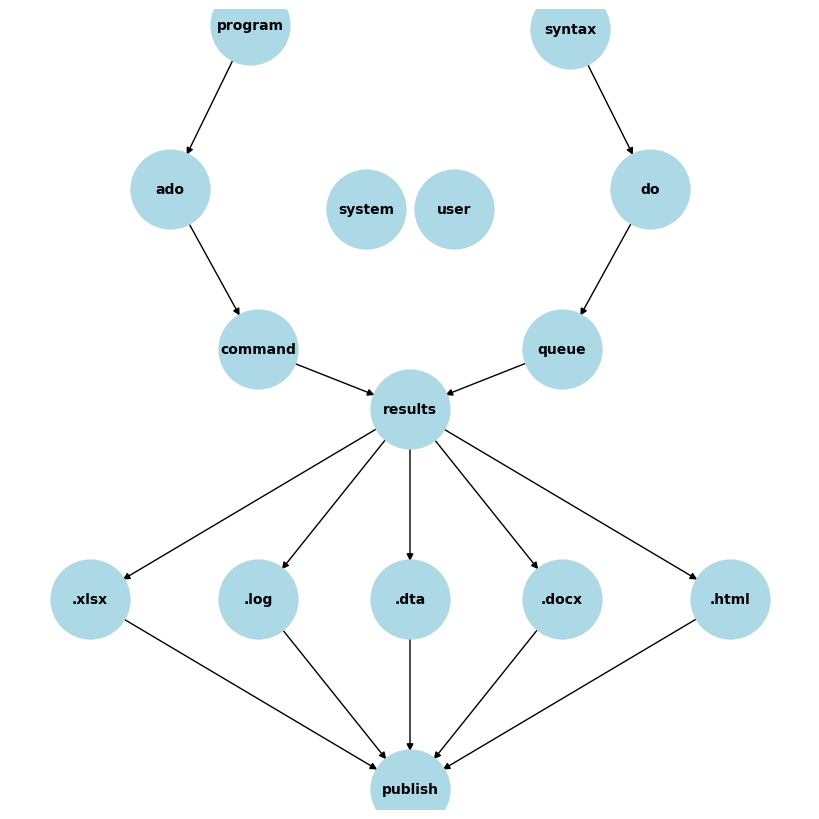Hub 🦀#
Show code cell source
import networkx as nx
import matplotlib.pyplot as plt
G = nx.DiGraph()
G.add_node("user", pos=(550, 500))
G.add_node("system", pos=(-550, 500))
G.add_node("program", pos=(-2000, 960))
G.add_node("syntax", pos=(2000, 950))
G.add_node("ado", pos=(-3000, 550))
G.add_node("do", pos=(3000, 550))
G.add_node("command", pos=(-1900, 150))
G.add_node("queue", pos=(1900, 150))
G.add_node("results", pos=(0, 0))
G.add_node("dta", pos=(0, -475))
G.add_node("log", pos=(-1900, -475))
G.add_node("excel", pos=(-4000, -475))
G.add_node("word", pos=(1900, -475))
G.add_node("html", pos=(4000, -475))
G.add_node("publish", pos=(0, -950))
G.add_edges_from([("program", "ado"), ("syntax", "do")])
G.add_edges_from([("ado", "command"), ("do", "queue")])
G.add_edges_from([("command", "results"), ("queue", "results"), ("results", "excel"), ("results", "word"), ("results", "html")])
G.add_edges_from([("results", "dta"), ("results", "log")])
G.add_edges_from([("dta", "publish"), ("log", "publish"), ("excel", "publish"), ("word", "publish"), ("html", "publish")])
pos = nx.get_node_attributes(G, 'pos')
labels = {"user": "user",
"system": "system",
"program": "program",
"syntax": "syntax",
"ado": "ado",
"do": "do",
"command": "command",
"queue": "queue",
"results": "results",
"dta": ".dta",
"log": ".log",
"excel": ".xlsx",
"word": ".docx",
"html": ".html",
"publish": "publish"}
plt.figure(figsize=(8, 8))
nx.draw(G, pos, with_labels=False, node_size=3000, node_color="lightblue", linewidths=3)
nx.draw_networkx_labels(G, pos, labels, font_size=10, font_weight='bold')
plt.xlim(-5000, 5000)
plt.ylim(-1000, 1000)
plt.axis("off")
plt.show()

CoursePlus - Post questions, dropoff homework, receive feedback
User - Understanding user interface in Stata
System - Understanding the Stata system environment
Syntax - Basics of Stata syntax
Command - Mastering Stata commands
Do-file - Learning to write and execute Do-files
Ado-file - Creating and using Ado-files
Program - Building your own Stata programs
Queue - Managing tasks and operations with Queue
Dataset-formats - Understanding and working with different Stata dataset formats
Excel - Importing and exporting Excel data in Stata
Log-file - Generating and understanding log files in Stata
Microsoft Word - Exporting Stata output to Microsoft Word
Results-window - Understanding and interpreting the Results window in Stata
Iterating - Using loops and other iterative constructs in Stata
Version-control - Managing Stata code and versions effectively
Collaboration - Understanding and leveraging collaboration in Stata
Sub-topic: Collaborative Coding in Stata
HyperText & Markups - Using HTML and other markup languages with Stata output
Publishing - The process of publishing Stata output
Sub-topic: Publishing in Stata
Teaching Assistants - How to make use of teaching assistants for your course
Labs & Homeworks - Overview of labs and homeworks in the course
Grades & Feedback - Understanding the grading rubric and feedback process
OpenAI & ChatGPT - Using artificial intelligence tools to expedite learning
Troubleshooting & FAQs - Common issues and solutions in Stata programming
Hands-on Practice - Practice problems and exercises to apply what you’ve learned
Additional Resources - Further reading and additional resources for learning Stata
Career Guidance - Potential career paths and tips for job interviews in Stata-related fields
Work Opportunities - Opportunities for work and internships in Stata-related fields
Course Evaluation - Understanding and giving feedback through course evaluation
Recommendations - Recommendations for further learning and improvement
Mentorship & More - Opportunities for mentorship and additional learning resources
See also
Last update 4:48 AM July 18, 2023
\(\beta\)-testing for the Spring 2024 class book
Please keep the link handy
Will ask for your feedback each month
